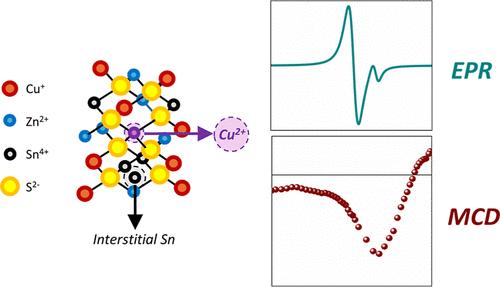当前位置:
X-MOL 学术
›
J. Phys. Chem. C
›
论文详情
Our official English website, www.x-mol.net, welcomes your feedback! (Note: you will need to create a separate account there.)
Environmentally Friendly Pathway to Kesterite Nanoparticles with Controlled Sn Content: An In-Depth Study of Magnetic and Optical Properties
The Journal of Physical Chemistry C ( IF 3.3 ) Pub Date : 2024-06-21 , DOI: 10.1021/acs.jpcc.4c02095 Alessandro Veneri 1 , Alberto Privitera 2, 3 , Alessio Gabbani 4, 5 , Beatrice Muzzi 6 , Maurizio Becucci 1 , Andrea Caneschi 2 , Francesco Di Benedetto 7 , Francesco Pineider 4, 5 , Lorenzo Sorace 1 , Matteo Mannini 1
The Journal of Physical Chemistry C ( IF 3.3 ) Pub Date : 2024-06-21 , DOI: 10.1021/acs.jpcc.4c02095 Alessandro Veneri 1 , Alberto Privitera 2, 3 , Alessio Gabbani 4, 5 , Beatrice Muzzi 6 , Maurizio Becucci 1 , Andrea Caneschi 2 , Francesco Di Benedetto 7 , Francesco Pineider 4, 5 , Lorenzo Sorace 1 , Matteo Mannini 1
Affiliation

|
Copper-poor Cu2ZnSnS4 (copper zinc tin sulfide, CZTS) inorganic semiconducting nanoparticles were synthesized by an environmentally friendly low-temperature (100 °C) synthetic path, which allows precise control of the Sn content without any relevant presence of Zn- and Sn-related secondary phases. The resulting nanoparticles are polycrystalline and quasi-spherical, with an average diameter of 10 nm. The shape and composition were assessed using a multitechnique approach based on X-ray photoelectron spectroscopy (XPS), energy-dispersive fluorescence X-ray spectroscopy (EDXRF), inductively coupled plasma atomic emission spectrometry (ICP-AES), and high-resolution transmission electron microscopy (HR-TEM). The presence of paramagnetic species associated with Cu2+ cations was highlighted by electron paramagnetic resonance (EPR) spectroscopy, pinpointing the presence of significant exchange interactions between Cu2+ ions. The mixed oxidation state of Cu induces the generation of free holes, which are confined in the nanoparticles, giving rise to a plasmonic resonance. The plasmonic properties were investigated as a function of Sn doping through vis–NIR absorption spectroscopy combined with magnetic circular dichroism (MCD). This approach enabled the extraction of charge carriers’ density and mass, a key step for further optimization of CZTS-based photovoltaic devices.
中文翻译:

锡含量受控的黄锡矿纳米粒子的环保途径:磁学和光学性质的深入研究
通过环境友好的低温(100°C)合成路径合成了贫铜Cu 2 ZnSnS 4 (铜锌锡硫化物,CZTS)无机半导体纳米颗粒,可实现精确的合成控制 Sn 含量,而不存在任何与 Zn 和 Sn 相关的第二相。所得纳米粒子是多晶的、准球形的,平均直径为10 nm。使用基于 X 射线光电子能谱 (XPS)、能量色散荧光 X 射线能谱 (EDXRF)、电感耦合等离子体原子发射光谱 (ICP-AES) 和高分辨率透射的多种技术方法评估形状和成分电子显微镜(HR-TEM)。电子顺磁共振 (EPR) 光谱强调了与 Cu 2+ 阳离子相关的顺磁性物质的存在,查明了 Cu 2+ 离子之间存在显着的交换相互作用。 Cu 的混合氧化态诱导自由空穴的产生,这些空穴被限制在纳米颗粒中,从而引起等离子体共振。通过可见近红外吸收光谱与磁圆二色性(MCD)相结合,研究了等离子体特性与锡掺杂的函数关系。这种方法能够提取载流子的密度和质量,这是进一步优化基于 CZTS 的光伏器件的关键一步。
更新日期:2024-06-21
中文翻译:

锡含量受控的黄锡矿纳米粒子的环保途径:磁学和光学性质的深入研究
通过环境友好的低温(100°C)合成路径合成了贫铜Cu 2 ZnSnS 4 (铜锌锡硫化物,CZTS)无机半导体纳米颗粒,可实现精确的合成控制 Sn 含量,而不存在任何与 Zn 和 Sn 相关的第二相。所得纳米粒子是多晶的、准球形的,平均直径为10 nm。使用基于 X 射线光电子能谱 (XPS)、能量色散荧光 X 射线能谱 (EDXRF)、电感耦合等离子体原子发射光谱 (ICP-AES) 和高分辨率透射的多种技术方法评估形状和成分电子显微镜(HR-TEM)。电子顺磁共振 (EPR) 光谱强调了与 Cu 2+ 阳离子相关的顺磁性物质的存在,查明了 Cu 2+ 离子之间存在显着的交换相互作用。 Cu 的混合氧化态诱导自由空穴的产生,这些空穴被限制在纳米颗粒中,从而引起等离子体共振。通过可见近红外吸收光谱与磁圆二色性(MCD)相结合,研究了等离子体特性与锡掺杂的函数关系。这种方法能够提取载流子的密度和质量,这是进一步优化基于 CZTS 的光伏器件的关键一步。






































 京公网安备 11010802027423号
京公网安备 11010802027423号